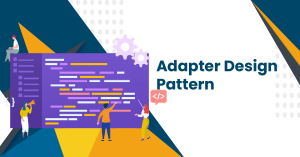Introduction to Adapter Class In Java
In the Java programming language, the adapter class in Java is the default implementation of listener interfaces in Java provided via adapter classes. If you inherit the adapter class, you will not be required to implement all of the listener interface functions. As a result, it saves code.
Java is a most famous general-purpose, object-oriented programming language based on classes that are designed to have fewer implementation requirements. It is a computer platform for the development of applications. As a result, Java is quick, secure, and dependable. It’s commonly used in laptops, data centers, game consoles, scientific supercomputers, cell phones, and other places to construct Java applications. Java and Python are some of the most famous programming languages. You can read the comparison between Java and Python.
Java can lend some of the highest paying job in IT. Java is one of the most extensively used programming languages, and it is utilized as the server-side language for the majority of back-end development projects, including big data and Android development. Here are a few key Java applications:
- It’s used to create Android apps
- Delivers aid in the development of enterprise software
- Creator uses Java to develop mobile Java applications
- Applications of Scientific Computing
- Java Programming for Big Data Analytics
- Server-side technologies such as Apache
What is an Adapter-Class in Java?

The Adapter class in Java allows us to edit all of an interface’s methods by default; we don’t have to modify all of the interface’s methods, therefore we may claim it minimizes the coding burden. We may require a few interface methods on occasion or on a regular basis. The Adapter class comes in handy here because it already alters all of an interface’s methods, so all we have to do is implement the Adapter class in Java and edit the required methods.
The user interacts with the system via connected visuals and graphics in most event-driven GUI programming. This means that any action taken by the user, like moving the mouse pointer on the screen to alter its coordinates, clicking a button, or navigating a page, is treated as an independent event.
Each of these distinct event actions is intrinsically tied to a subprogram that iterates the application’s response to the user. The path is straightforward. An event is generated by the user (source) and sent to listener interfaces.
In JAVA, an adapter class in Java is being used to extend an interface with a set of dummy methods. When a programmer imports an adapter class, they are not obligated to implement all of the methods mentioned under each listener interface. The adapter class in java can also be subclassed, allowing the programmer to override only the methods that are required.
In a nutshell, All methods in an event listener interface are implemented by an adapter class in Java, which is an empty implementation. When you just wish to receive and process a subset of the events handled by a given event listener interface, adapter classes come in handy. By expanding a few of the adapter classes and executing only the events in which you are interested, you can create a new class to act as a listener. If you want to become full-stack developer, Java is one of the important language.
Relationship Between Adapter Class in Java And Listener Interface

Definition
The interfaces responsible for handling events are represented by the Event listener. Java includes a number of Event listener classes, but we’ll focus on the ones that are most commonly used. Every event listener method takes a single argument in the form of an object that is a subclass of the EventObject class. Mouse event listener methods, for example, will receive an instance of MouseEvent, which is derived from EventObject.
Also Read : What is Synchronize in Java?
Class Declaration
Public Interface EventListener
Types of Listener Interface
|
Interface |
Description |
|
WindowListener |
The interface is used for getting the action events. |
|
KeyListener |
This interface is used for getting the key events. |
|
MouseListener |
This interface is used for getting the mouse events. |
|
MouseMotionListener |
This interface is used for getting the mouse motion events. |
|
FocusListener |
This interface is used for getting the focus events. |
|
ComponentListener |
This interface is used for getting the component events. |
Relationship between Listener & Adapter Class
When a programmer plans to use the majority of the methods specified under the interface, listeners are employed. If a class implements a listener interface directly, it must implement all of the interface’s methods, which makes the code excessively big. The use of an adapter class in java can help to fix this problem. When an event just requires a few specialized methods, an adapter class comes in handy.
Example
Consider the MouseListener interface as an example to better grasp this. When the status of the mouse changes, this interface receives a notification. Even if only one of these techniques is required when alerted of an event, all of them must be implemented. Methods that aren’t used are left blank. To avoid the implementation of an empty method body, an adapter class is utilized.
What is an Adapter Design Pattern?

Definition of Adapter Design Pattern
An adapter design pattern is a structural design pattern that enables two separate interfaces to communicate with each other. The adapter pattern can make two incompatible interfaces work together without requiring any changes to their current code. Although the interfaces may be incompatible, the inner functionality must meet the criterion.
The adapter approach is widely used to extend the functionality of an existing class without altering its source code. They also employ a single class to connect the functionality of disparate or incompatible interfaces. The wrapper is another term for the adapter pattern, and it is used interchangeably with the decorator design pattern.
The pattern also transforms a class’s incompatible interfaces into other interfaces that are identical to the target. Adapter patterns also allow classes to interact with one another; otherwise, interfaces would be nearly incompatible. Consider a person who travels frequently to different nations with his laptop and cell phone to put things
into perspective.
Example
Various countries have diverse electric connectors, voltages, and frequency measurements, which makes it difficult for any appliance from one country to work in another. A Type G socket with 230 volts and a 50 Hz frequency is extensively used throughout the United Kingdom.
Type A and Type B plug with 120v and 60 Hz frequencies are used in the United States. Type C, Type D, and Type M plugs of 230 v and 50 Hz are often used in India. Finally, Type A and Type B sockets with a voltage of 110 volts and a frequency of 50 Hz are utilized in Japan.
As a result, we might deduce that the equipment we bring could be mismatched with the electrical specifications in use at various locations. Adapter tools, on the other hand, are necessary since they can transform incompatible code to compatible code.
Types of Adapter Class in Java

Adapter Classes in Java are not a novel concept. They’re responsible for implementing Listener interfaces. The adapter class in Java has the benefit of saving code. We won’t have to implement all of the listener interface methods if we derive the adapter class via the Adapter interface. The adapter class in Java can be found in three different packages. The three packages are as follows:
java.awt. event | Adapter Class in Java
The package java.awt.event contains all of the classes required for event handling in Java. Each event class has a user interface that you can use to create handlers for it. A Java interface is made up entirely of abstract methods. If you build a class that implements an interface, whether you use it or not, you must supply an implementation for each of its methods (the conventional practice is to provide it an empty block if you don’t use it).
To make programming easier, the java.awt.event package includes classes that implement the interfaces and offer default implementations for their methods (usually doing nothing). A listener interface is a name given to an event handling interface in the Java API.
An event occurs when the state of an object transforms. For instance, clicking a button, dragging the mouse, and so forth. For event handling, the java.awt.event package includes a number of event classes and Listener interfaces.
|
Adapter Class |
Listener Interface |
|
WindowAdapter |
WindowListener |
|
KeyAdapter |
KeyListener |
|
MouseAdapter |
MouseListener |
|
MouseMotionAdapter |
MouseMotionListener |
|
FocusAdapter |
FocusListener |
|
ComponentAdapter |
ComponentListener |
|
ContainerAdapter |
ContainerListener |
|
HierarchyBoundsAdapter |
HierarchyBoundsListener |
java.awt.dnd | Adapter Class in Java
The java.awt.dnd package, which is new in Java 1.2, comprises classes and interfaces that facilitate data transfer using the drag-and-drop metaphor. This feature is based on the java.awt.datatransfer package’s data transfer framework. A DropTarget object is a proxy for an object that desires to receive drops, whereas a DragSource object is a proxy for an item that begins a drag. The many event classes offered by this package handle all inter-object communication throughout the drag operation.
|
Adapter Class |
Listener Interface |
|
DragSourceAdapter |
DragSourceListener |
|
DragTargetAdapter |
DragTargetListener |
java.swing. event | Adapter Class in Java
The javax.swing.event package extends the java.awt.event package by providing Swing-specific event objects, listeners, and adapters. Event types are defined by classes with names that finish in “Event,” and their fields and methods give information about the occurrence. Event listeners are interfaces with names that conclude in “Listener.”
These interfaces’ methods are used to alert interested objects when certain events occur. Listener interface implementations with names ending in “Adapter” are handy no-op implementations. Subclassing an adapter class is usually easier than writing the equivalent listener interface from scratch.
|
Adapter Class |
Listener Interface |
|
MouseInputAdapter |
MouseInputListener |
|
InternalFrameAdapter |
InternalFrameListener |
Adapter Class in Java with Example

The default execution of listener interfaces in Java is provided via adapter classes. If you derive the adapter class, you will not be required to implement all of the listener interface functions. As a result, it saves users from coding the same code again and again.
Window Adapter class in Java
WindowAdapter is an adapter class in Java that is used to receive window events. This class’s methods are all empty. This is a utility class for constructing listener objects.
Syntax:-
AdapterExample()
{
f=new Frame(“Hello World”);
f.addWindowListener(new WindowAdapter()
public void windowClosing(WindowEvent e)
{
f.close();
}
}
Key Adapter Class in Java
KeyAdapter is an adapter class in Java. KeyAdapter is used to receive keyboard events. This class’s methods are all empty. This is a utility class for building listener objects.
Class Declaration
- Public Abstract Class KeyAdapter
- Extends Object
- Implements KeyListener
Mouse Adapter Class in Java
MouseAdapter is an adapter class in Java that is used to receive mouse events. This class’s methods are all empty. This is a utility class for building listener objects.
Class Declaration
- Public Abstract Class MouseAdapter
- Extends Object
- Implements MouseListener, MouseWheelListener, MouseMotionListener
Advantages of Adapter Class in Java
It makes it easier for unrelated classes to function together and allows you to use classes in a variety of ways. It has the potential to improve class transparency. Within a class, an adapter class allows you to integrate related patterns. Users have the option of using a pluggable kit to develop apps. As a result, class usage becomes extremely reusable.
- Unrelated classes can function together with the help of an adapter class.
- The very same class can be utilized in numerous ways with the help of an adapter class in Java.
- Users have the option of using a pluggable kit to create apps. As a result, class usage becomes extremely reusable.
- It improves the visibility of classes.
- It allows you to group patterns together in a class.
- It makes it easier for classes that aren’t connected to work together.
- It allows you to use classes in a
variety of ways. - It improves the visibility of classes.
- It allows for the inclusion of related patterns in the class.
- It provides a pluggable application development kit.
- It improves the class’s reusability.
Difference Between Adapter Class in Java And Object Adapter

Class Adapter
Multiple inheritances are used by class adapters to fulfill their aims. The class adapter, like the object adapter, inherits the client’s target’s interface. It does, however, inherit the adapter’s interface as well. Due to the fact that Java does not enable real multiple inheritances, a few of the interfaces should be acquired from a Java Interface class. It’s important to note that either the target or adapter interfaces might be Java Interfaces. The target request is simply redirected to the particular request inherited from the adapter interface.
Object Adapter
Object adapters convert one interface to another using a compositional method. While holding an instance of the adapter, the adapter derives the target interface that the user expects to see. The request is converted into the matching individual demand of the adoptee when the client performs the request() function on its particular object (the adapter). Object adapters allow the user and also the adapter to somehow be totally disconnected. Only the adapter is aware of their existence.
Conclusion
We’ll look at how Java adapter classes function in this post, and we’ll see that there are three main categories that include the adapter classes. We can see the syntax for all of the adapter class in java that are there, along with some of the actual examples. The adapter class in Java is one-of-a-kind, and they’re part of the Swing feature.
Frequently Asked Questions of Adapter Class in Java
1. What is the adapter class in Java?
The adapter pattern is used to define a class called an adapter class. An adapter can be used to extend the functionality of an existing class without changing it. The adapter pattern is used to expand the functionality of an existing class without having to change its code.
2. What are adapter classes used for?
The basic implementation of all functionalities in an event listener interface is provided by an adapter class. When you just want to process a subset of the events handled by a certain event listener interface, adapter classes come in handy.
3. What are the advantages of using the adapter class in Java?
The basic implementation of all functionalities in an event listener interface is provided by an adapter class. When you just want to process a subset of the events handled by a certain event listener interface, adapter classes come in handy.
4. What are the advantages of using the adapter class in Java?
It makes it easier for unrelated classes to function together and allows you to use classes in a variety of ways. It has the potential to improve class transparency. Within a class, an adapter class allows you to integrate related patterns. Users have the option of using a pluggable kit to develop apps. As a result, class usage becomes extremely reusable.
5. How many adapter classes are used in Java?
The Java adapter classes can be found in three different packages. The three packages are-
- java.awt.event
- java. awt. dnd
- javax. swing.event
Java AWT (Abstract Window Toolkit) is a Java API for creating graphical user interface (GUI) or window-based applications. Platform-dependent Java AWT elements are shown in accordance with the operating system’s perspective.
7. What is an adapter design pattern in Java?
In software design, a design pattern is a generic, reusable solution to a frequent problem in a specific environment. It’s not a finalized layout that can be turned into code right away. It’s a description or template for solving an issue that may be applied to a variety of scenarios.. In Java, there are various design patterns to choose from. A design pattern does not have to be derived from a different language.
8. What is the difference between the adapter class and the listener interface?
All of the methods given in an interface do not need to be implemented in an adapter class. It’s used when only a few of the interface’s methods need to be changed. All of the methods defined in a listener’s interface must be implemented.
9. What are adapter and wrapper classes in Java?
A wrapper, such as the one used in the Facade pattern, is designed to make interacting with an external library easier. The purpose of an adapter is to bridge the gap between two interfaces. You may look at a new library you want to utilize and develop a wrapper to make it easier to use.
10. What is an object adapter?
An object’s principal means of accessing ORB services like object reference creation is through an object adapter. Standard interfaces are exported to the object using a portable object adaptor. An object adapter’s major tasks are to generate and understand object references.
11. What is the difference between a class adapter and an adapter?
The primary distinction: Class Adapter is a wrapper for a class that leverages inheritance. It can’t encapsulate an interface since it must originate from a base class by definition. Composition is used by Object Adapter, which can encapsulate classes, interfaces, or both.













2 responses to “What is Adapter Class in Java? – DataTrained”
[…] about the game, game developers must be knowledgeable in hardware technology as well as C, C#, C++, Java, Python, Lua, and other programming languages. While you may have learned them as part of your […]
[…] out Adapter Class in Java for […]